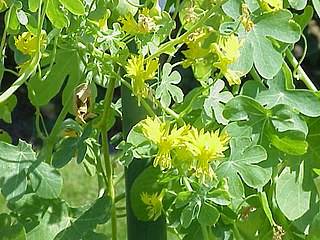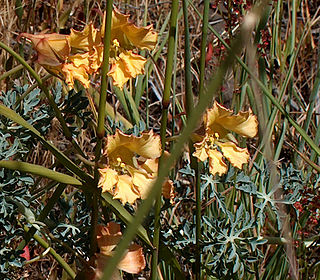
Tropaeolum, commonly known as nasturtium, is a genus of roughly 80 species of annual and perennial herbaceous flowering plants. It was named by Carl Linnaeus in his book Species Plantarum, and is the only genus in the family Tropaeolaceae. The nasturtiums received their common name because they produce an oil similar to that of watercress.

Nasturtium is a genus of seven plant species in the family Brassicaceae, best known for the edible watercresses Nasturtium microphyllum and Nasturtium officinale. Nasturtium was previously synonymised with Rorippa, but molecular evidence supports its maintenance as a distinct genus more closely related to Cardamine than to Rorippasensu stricto. Watercress or yellowcress is a common name for plants in this genus.

Persicaria maculosa is an annual plant in the buckwheat family, Polygonaceae. Common names include lady's thumb, spotted lady's thumb, Jesusplant, and redshank. It is widespread across Eurasia from Iceland south to Portugal and east to Japan. It is also present as an introduced and invasive species in North America, where it was first noted in the Great Lakes region in 1843 and has now spread through most of the continent.

Tropaeolum tuberosum is a species of flowering plant in the family Tropaeolaceae, grown in the Andes, particularly in Peru and Bolivia, and to a lesser extent in Ecuador as well as in some areas of Colombia, for its edible tubers, which are eaten cooked or roasted as a vegetable. It is a minor food source, especially to native Amerindian populations. Mashua is a herbaceous perennial climber growing to 2–4 m (7–13 ft) in height. It is related to garden nasturtiums, and is occasionally cultivated as an ornamental for its brightly coloured tubular flowers.

Cornus sericea, syn. C. stolonifera, Swida sericea, red osier or red-osier dogwood, is a species of flowering plant in the family Cornaceae, native throughout northern and western North America from Alaska east to Newfoundland, south to Durango and Nuevo León in the west, and Illinois and Virginia in the east. It has sometimes been considered a synonym of the Asian species Cornus alba. Other names include red brush, red willow, redstem dogwood, redtwig dogwood, red-rood, American dogwood, creek dogwood, and western dogwood.

Tropaeolum peregrinum, the canary-creeper, canarybird flower, canarybird vine, or canary nasturtium, is a species of Tropaeolum native to western South America in Peru and possibly also Ecuador.

Tropaeolum majus, the garden nasturtium, nasturtium, Indian cress or monks cress is a species of flowering plant in the family Tropaeolaceae, originating in the Andes from Bolivia north to Colombia. An easily-grown annual with disc-shaped leaves and brilliant orange or red flowers, it is of cultivated, probably hybrid origin. It is not closely related to the genus Nasturtium.

Arctium minus, commonly known as lesser burdock, little burdock, louse-bur, common burdock, button-bur, cuckoo-button, or wild rhubarb, is a biennial plant. This plant is native to Europe, but has become introduced elsewhere such as Australia, North and South America, and other places.
Tropaeolum magnificum is a species of plant in the Tropaeolaceae family. It is endemic to Ecuador. Its natural habitats are subtropical or tropical moist montane forests and subtropical or tropical high-altitude grassland.

Tropaeolum umbellatum is a species of plant in the Tropaeolaceae family. It is endemic to Ecuador. Its natural habitat is subtropical or tropical moist montane forests.

Thalictrum minus, known as lesser meadow-rue, is a perennial herb in the family Ranunculaceae that is native to Europe, Northwest Africa, Yemen, Ethiopia, South Africa, Southwest Asia, and Siberia. It grows on sand dunes, shingle, coastal rocks or calcareous grassland, cliffs and rocky gullies at up to 1,600 to 3,000 m elevation at southern latitudes. It grows to 30 cm (0.98 ft) tall with erect stems and 1 cm (0.39 in) leaves that are highly subdivided, 3-4 ternate to pinnate.

Tropaeolum speciosum, the flame flower or flame nasturtium, is a species of flowering plant in the family Tropaeolaceae native to Chile, where it is known locally as coralito, quintralito, or voqui.

Tropaeolum tricolor, the three-coloured Indian cress or Chilean nasturtium, is a species of perennial plant in the family Tropaeolaceae. It is endemic to Chile, where it is called soldadito rojo and relicario.

Tropaeolum polyphyllum is a species of flowering plant in the nasturtium family Tropaeolaceae. It is endemic to mountainous regions of Chile and Argentina where it is called in Spanish soldadito grande de la cordillera.

Tropaeolum brachyceras is a species of perennial plant in the Tropaeolaceae family. It is endemic to mountainous regions of Chile.

Tropaeolum leptophyllum is a perennial climber in the Tropaeolaceae family. It is endemic to mountainous regions of Chile.

Tropaeolum incisum is a species of nasturtium, with flaring petals in shades of yellow and peach, when still in bud and on the outside darker, more orange-brown and sometimes stained purple, with creeping or climbing stems, in the wild up to about 60 cm long with deeply divided, blue-grey leaves, with undulating lobes, that grows on the dry eastern side of the southern Andes mountains.
Tropaeolum argentinum is a climbing or scrambling plant from Argentina with yellow feathery flowers. It was introduced to cultivation in 2007 by plant collectors John Watson and Anita Flores Watson.
Tropaeolum beuthii is a species of flowering plant in the family Tropaeolaceae, native to Northern Chile. Growing to 1 m (3.3 ft) in height, it is a tuberous summer-dormant climber. It belongs to the same genus as the more familiar annual nasturtium of gardens, Tropaeolum majus.

Tropaeolum hookerianum is a species of perennial plant in the Tropaeolaceae family. It is found in Chile.

















